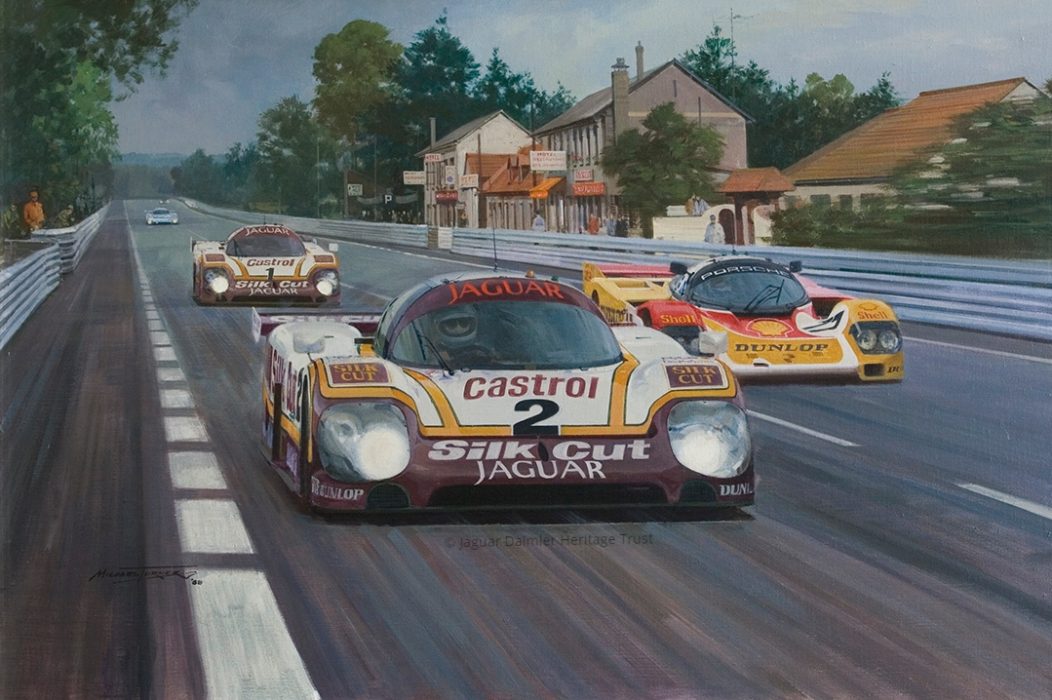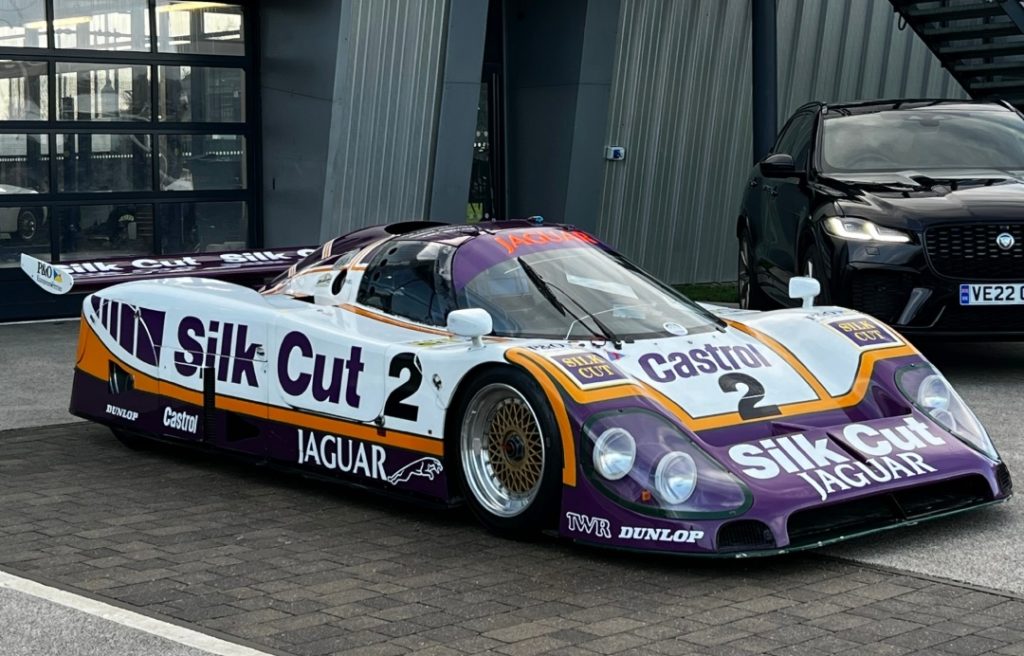
Jaguar XJR9 – 1988 Le Mans 24 Hours, Michael Turner, 1990
The Artwork
This is one of six paintings by artist Michael Turner in the Jaguar Daimler Heritage Trust’s Collection, and depicts the Jaguar XJR9, Car #2, of Johnny Dumfries, Jan Lammers and Andy Wallace which earned Jaguar its 6th Le Mans win in 1988. It is blasting past Les Hunaudieres restaurant on the Mulsanne straight, ahead of the second placed Porsche 962 of Bell, Ludwig and Stuck and XJR9 Car #1 of Martin Brundle and John Nielsen.
Car #2 went on to win the race completing 394 laps, covering 5,332.970 kms, at an average speed of 221.765 km/h (137.79 mph) ahead of the Porsche which also completed 394 laps but with an average speed of 221.665 km/h (137.74 mph).
The Brundle/Nielsen Jaguar XJR9, Car #1, retired after 306 laps with head gasket failure.
TWR team manager Tom Walkinshaw arranged for three of the XJR9s, Cars #2, 22 and 21, to cross the finish line one after the other. While this produced one of the iconic photographs from the race, a good photo wasn’t the main reason. The winning car developed gearbox problems meaning Jan Lammers had to finish the race in 4th gear and Walkinshaw has gone on record saying he told the other drivers to: “get behind Lammers, and if he has problems, you are to push the damn thing home”.
The painting has Turner’s characteristic sense of speed about it, and gives a good impression of the Mulsanne straight, one of the iconic parts of the Le Mans circuit.
The painting is currently on public display in the Collections Centre at the British Motor Museum at Gaydon.
The Artist
Michael Turner was born in Harrow, Middlesex, in 1934. Raised in the suburbs of London during the Second World War, he was inspired by the exploits of the R.A.F. and developed an early talent for aircraft recognition, drawing aeroplanes in his school exercise books to the chagrin of his teachers. This enthusiasm for aviation found a parallel passion in the thrill of motor racing after a holiday visit to the Isle of Man in 1947, where he chanced to see the first post war revival of the British Empire Trophy Race. From that moment, with the indulgence of his parents until he reached driving age, he attended as many motor sport events as possible, including the first ever meetings at Silverstone and Goodwood and the Jersey Road Races.
After completing his formal education, he spent a year at Art College followed by two years National Service with the Royal Electrical and Mechanical Engineers. Three years in advertising studios in London provided valuable experience and in 1957 he went freelance. With a strong belief that there is no substitute for first hand involvement in order to portray such demanding subjects with authority and feeling, he travelled to the world’s major race tracks to satisfy his need for authenticity, and he continues to visit several Grand Prix each year.
His interest in aircraft led him to become a founder member of The Guild of Aviation Artists, of which he has twice been Chairman and is now President, and an Honorary Fellow of the Guild of Motoring Artists. His clients include many racing drivers, teams, sponsors, pilots, motor and aircraft manufacturers, R.A.F. and Army messes, museums and private collections worldwide. He held one man exhibitions in London, New York, Australia and the U.S.A., and participated in specialist shows in the U.K. and Europe. He had six books of his paintings published covering aircraft of the Royal Air Force and Luftwaffe, Formula One Motor Racing, Aviation Art, Monaco Grand Prix and Motor Sport Art.
The Car
This winning XJR9 was retained by Jaguar Cars and transferred to the Jaguar Daimler Heritage Trust.
It is maintained in running condition by our technicians and is regularly used for ‘demonstration’ purposes at Historic Races and motoring events, including including Goodwood, Coventry Motofest and Le Mans.
Click the button for more information on either the XJR9 or the 1988 Le Mans race:
